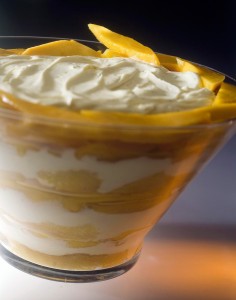Cheeky Mangoes
Tell me, can there be a more seductive fruit than the mango? Juicy, succulent and fragrant – I can’t resist sinking my teeth into the soft ripe flesh and letting the juices run down over my chin while inhaling those wonderfully evocative aromas. Easier, of course, if you cut off their cheeks first.
I’m referring to those gorgeous Kensington Prides (or Bowens) which we grow in our northern tropical regions. A glorious orange-yellow colour with a pink flush, their flesh is deep orange and relatively free of fibre.
Definitely the”king of fruits”.
Mangoes always remind me of hot steamy days. Makes sense when you know that they are a native of SouthEast Asia and have been cultivated for over 4,000 years in India.
In Australia the ‘mangifera indica’ is our most important tropical fruit crop, and has been grown in Queensland since 1840.
Mangoes vary in size, colour, flavour and skin colour. Some are yellow-green when ripe, others a deep orange, red or straw colour or a combination of all three. However don’t judge the ripeness of a mango by its colour – some can be perfectly ripe and the skin remain green; others may have a crimson blush but not still ripe. Unripe mangoes have a strong kerosene smell and can be used to make chutney, or dried to make ‘amchur’, a tangy Indian spice.
Varieties of Mangoes:
Kensington Pride – orange yellow with pink flush; moderate amount of fibre with sweet aromatic flesh.
R2E2 – yellow-green skin background with orange-red blush; smooth flesh with good flavour which is sweet and slightly acid.
Sensation – beautiful deep red-yellow colour with red-purple blush; slight tomoderate fibre content with sweet bland and somewhat spicy flavour.
Early Gold – golden-yellow with red blush; mild, sweet-flavoured flesh with a smooth fibreless juicy texture.
Irwin – orange-yellow with deep purple-pink blush and smooth fibreless flesh (varies from having sweet to bland flavour depending on growing region).
Keitt – dark green skin which sometimes develops a dull bronze-red blush when ripe; flesh is dark orange with rich, sweet, mild and juicy smooth flesh;sometimes the flesh has a fibrous consistency around the seed.
Kent – greenish-yellow with red-purple blush around shoulder; rich sweet flesh with smooth texture.
Glenn – red-yellow skin with strong sweet flavour and juicy smooth flesh.
Haden – yellow skin with a brilliant red blush; flesh is dark yellow with mild sweet flavour and low to moderate amount of fibre.
Nam Dok Mai – green-yellow skin, sometimes with a pink blush, very sweet flavour and smooth texture.
Palmer – red-yellow skin with sweetly aromatic smooth juicy flesh.
Mango and Lime Tiramisu
A fabulous contemporary version of the classic rich Italian dessert. You will need a dish with a 2 litre capacity and a depth of at least 5cm.
4 large mangoes
250ml freshly squeezed orange juice
3 tbsp Cointreau
250g pkt sponge finger biscuits (savoiardi)
500g mascarpone
3 eggs, separated
50g (1/4 cup) caster sugar
Finely grated zest and juice of 1 large lime
Peel and slice the mangoes into thin slices.
In a shallow dish, mix together the orange juice and Cointreau. Dip the biscuits in the mixture and lay over the base of the serving dish until it is completely covered.
Beat together the mascarpone, egg yolks, sugar, lime juice and finely chopped zest until smooth. Whisk the egg whites in a separate clean bowl until they form soft peaks. Fold through the mascarpone mixture.
Spread half the mascarpone mixture over the biscuits and top with a layer of mango. Repeat the process using up the remaining biscuits, mascarpone and mango. Cover with plastic wrap and chill for at least four hours.
Tip: the number of layers will depend on the size and depth of your dish.

